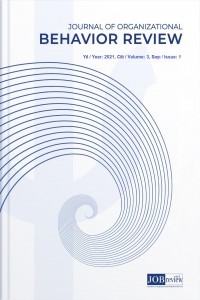Aile İşletmelerinde Başarının Anahtarı: Kişisel Niteliklerin, Yönetim Becerilerinin ve Fırsat Farkındalığının İncelenmesi
Bu araştırma, kişisel niteliklerin, yönetim becerilerinin ve fırsatları tanıma becerilerinin aile işletmelerinde girişim performansı üzerindeki etkisini incelemektedir. Çalışma, girişimcilik yetkinlikleri ile iş performansı arasındaki ilişkiyi araştırmak için mevcut literatüre dayanarak hipotezler oluşturan bir yaklaşım benimsenmektedir. Nitel ve nicel yöntemlerin bir kombinasyonunu kullanarak, veriler aile işletmelerinin sahipleriyle yapılan yarı yapılandırılmış telefon görüşmeleri aracılığıyla toplanmıştır. Toplanan veriler, tanımlanan yetkinlikler arasındaki ilişkileri ve tahmin edici ilişkileri incelemek için tanımlayıcı istatistikler, Pearson korelasyon katsayısı analizi ve regresyon analizi kullanılarak analiz edilmektedir. Bulgular, aile işletmelerinin sahiplerinin risk alma eğilimlerini ve iyimserliklerini sergilediğini, mücadeleci bir özellik olarak azimlerinin olduğunu, ancak karar verme ve görev devretme ile ilgili zorluklarla karşılaştıklarını ortaya koymaktadır. Araştırmada, araştırma, geliştirme ve pazar araştırmasına yönelik sınırlı bir vurgu olduğu görülmektedir. Analiz, fırsatları tanıma becerileri ile yönetim becerileri arasında güçlü bir pozitif ilişki olduğunu göstermektedir. Regresyon analizi, fırsatları tanıma becerileri, yönetim becerileri ve satış büyümesi arasında anlamlı ilişkilerin olduğunu teyit etmektedir. Bununla birlikte, yönetim becerileri satış büyümesi ile negatif bir ilişki sergilemektedir.
Anahtar Kelimeler:
Aile işletmeleri, Kişisel Nitelikler, Yönetim Becerileri
Unlocking Success in Family-Owned Businesses: An Examination of Personal Qualities, Management Skills and Opportunity Recognition
This research explores the influence of personal qualities, management skills, and opportunity recognition skills on venture performance in family-owned businesses. The study adopts a deductive approach, formulating hypotheses based on existing literature to investigate the relationship between entrepreneurial competencies and business performance. Using a combination of qualitative and quantitative methods, data is collected through semi-structured telephone interviews with family business owners. The collected data is analyzed using descriptive statistics, Pearson correlation coefficient analysis, and regression analysis to examine associations and predictive relationships among the identified competencies. The findings reveal that family business owners exhibit risk-taking tendencies and optimism, with perseverance as a major strength but facing challenges related to decision-making and delegation. Limited emphasis on research and development and market research is observed. The analysis indicates a strong positive association between opportunity recognition skills and managerial skills. Regression analysis confirms significant associations between opportunity recognition skills, managerial skills, and sales growth. However, managerial skills demonstrate an inverse relationship with sales growth.
Keywords:
Family businesses, Personal Qualities, Management Skills,
___
- Bird, B. (1995) Towards a theory of entrepreneurial competency, Advances in Entrepreneurship, Firm Emergence and Growth, 2, 51-72.
- Casson, M. (1999) The economics of the family firm, Scandinavian Economic History Review, 47(1), 10-23.
- Chakravarthy, B. S. (1986) “Measuring strategic performance”, Strategic Management Journal, 7(September/October), 437-458.
- Chandler, G. N. and Jansen, E. (1992) The founder’s self-assessed competence and venture performance, Journal of Business Venturing, 7(3), 223-236.
- Churchill, N. C. and Lewis, V. L. (1983) The five stages of small business growth, Harvard Business Review, 61(3), 1-12.
- Colli, A. (2003) The History of Family Business, 1850-2000, Cambridge: Cambridge University Press Etzioni, A. (1964) Modern Organizations, Englewood Cliffs: Prentice-Hall.
- Gibb, A. A. (1996) Entrepreneurship and small business management: can we afford to neglect them in the twenty-first century business school?, British Journal of Management, 17(4), 309-324.
- Hindle, K. and Yencken, J. (2004) Public research commercialization, entrepreneurship and new technologybased firms: an integrated model, Technovation, 24(10), 793-803.
- Hofer, C. W. and Charan, R. (1984) The transition to professional management: mission impossible?, American Journal of Small Business, 9(1), 1-11.
- Hofer, C. W. and Sandberg, W. R. (1987) Improving new venture performance: some guidelines for success, American Journal of Small Business, 12(1), 11-25.
- Hunt, C. and Meech, L. (1991) Competencies and human resource management in the Department of Immigration, Local Government and Ethnic Affairs, Australian Journal of Public Administration, 50(4), 444-447.
- Ibrahim, A. B.; Soufani, K. and Lam, J. (2003) Family business training: a Canadian perspective, Education and Training, 45(8/9), 474-482.
- Johnson, S. and Winterton, J. (1999) Management Skills, Skills Task Force Research Paper 3, Department for Education and Employment, London.
- Kreiser, P. M.; Ojala, J.; Lamberg, J. A. and Melander, A. (2006) A historical investigation of the strategic process within family firms, Journal of Management History, 12(1), 100-114.
- Upton, N.; Teal, E. J. and Felan, J. T. (2002) Strategie und Planung in rasch wachsenden Familienunternehmen, cited in Peters, M. (2005) “Succession in tourism family business: The motivation of succeeding family members, Tourism Review, 60(4), 12-18.
- Venkatraman, N. and Ramanujam, R. (1986) Measurement of business performance in strategy research: a comparison of approaches, Academy of Management Review, 11(October), 801-814.
- Ward, J. I. (1988) The special role of strategic planning for family business, Family Business Review, 1(2), 105-177.
- Zammuto, R. F. (1984) A comparison of multiple constituency models of organizational effectiveness, Academy of Management Review, 9(October), 606-616.
- ISSN: 2687-2609
- Yayın Aralığı: Yılda 2 Sayı
- Başlangıç: 2019
- Yayıncı: Sema POLATCI
